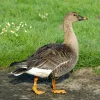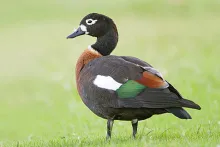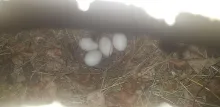
Australian Shelduck (Tadorna tadornoides)
Species name
- Dutch name:
- Australische casarca
- English name:
- Australian Shelduck, Chestnut-breasted Shelduck
- German name:
- Halsbandkasarka
- French name:
- Tadorne d`Australie
- Scientific name:
- Tadorna tadornoides
Scientific classification
- Order:
- Anseriformes
- Family:
- Anatidae
- Onderfamilie:
- Tadorninae
- Genus:
- Tadorna
Description
- Description:
Male:
Head and neck black, glossed green, quite often with small whitish are at base of upper mandible. White ring at base neck. Breast and mantle reddish - cinnamon. Rest of under-parts and upper-parts sooty- black , very finely vermiculated brown on under-parts, black and scapulars; rump, tail-converts and tail black, tail with greenish tinge . Wings with black outer wing, white forewing, and green glossed black seconderies forming speculum above with tertails chestnut. Bill , legs and feet dark grey.Female:
Smaller and very slightly duller on head and body , with well defined white ring around the eye and the base of the beak and a chestnut-colored breast. White neck collar narrower, chestnut of breast brighter.Juvenile:
Are similar in appearance to females but have more white around the eye
- Behaviour:
Pairs vigorously defend their breeding territory which may cover a whole dam or a portion of a large water body. Pairs probably remain together for life.
Standard Measurements
- Body Length (cm):
- The male (drake) of the Australian Shelduck measures approximately 59-72 centimeters. The female measures approximately 56-68 centimeters.
- Body Weight (grams):
- The male will weight about 1300-1600 gram. The female will weight about 1300-1600 gram.
The weight is notoriously variable and can only be used as indication!
- Note:
All Shelducks are reasonably hardy, but shelter should be available in winter. Enclosure should contain grass for grazing; generally peaceable and may be kept in mixed collections with e.g. Anser spp. and large ducks; some individuals are seasonally aggressive and may require a separate enclosure. In general younger birds (less than three years old) may be less aggressive than older birds. In addition to grass, feeding with e.g. wheat and pellets suggested, also earthworms, insects and extra green food for breeding, with duckweed particularly for ducklings.
They tend to be aggressive particularly in the breeding season, and may even kill small ducks, and a separate enclosure is usually required. There is some species-based and individual variation in degree of aggression.
Most species prefer to use a partially-buried nest box with a tunnel entrance, usually in the form of a drain pipe. A suggested nest box size is 30x30x40cm, with a 15cm diameter entrance tunnel drain pipe, or 15x15cm square entrance tunnel, minimum 30cm long. Ground-level nest boxes with a 15cm diameter entrance hole may also be used.
Not always easy to breed. Good fertility and hatchability in Australia. Ground-buried nest boxes, and buried or vegetation-hidden hollow logs and drainpipes should be provided for breeding, unless hollow trees or rabbit burrows are available. Laying may begin in February, usually lay March to May. Duckweed and rearing diet, plus small grains later, are useful for rearing ducklings. Artificial, broody and parent incubation and rearing may be used successfully. Care should be taken to avoid imprinting, which may lead to males aggressive to humans and females attracted to people.
Hybrids reported with Common shelduck (Tadorna tadorna), Ruddy shelduck (Tadorna ferruginea), South African shelduck (Tadorna cana), Paradise shelduck (Tadorna variegata), Ashy-headed goose (Chloephaga poliocephala), Bar-headed goose (Anser indicus) and domestic duck.
- Breeding:
- The female Australian Shelduck usually lays from 8-14 creamy white eggs and incubates them for 30-33 days.
- Artificial incubating:
The ideal relative humidity for incubating most waterfowl eggs is 55% (ground nesters) and 40% (cavity nesters). The temperature is usually 37.4°C. Set ventilation as recommended by the incubator manufacturer. Eggs must be turned, either automatically or by hand, a minimum of 4 times a day. As the duckling develops there is a loss of water from the egg and the air sac gets bigger. In normal development of an egg with a 30-33 days incubation, the air sac occupies about a third of it three days earlier. Cleanliness is vital and ideally eggs should be moved to a separate hatcher at this point, where the humidity should be increased to 65% and even higher once they have pipped internally.
- Bird banding:
- Recommended closed leg band ring size for the Australian Shelduck is 14 mm.The leg band ring can only be applied on a young shelduck at around 12-14 days old.
- It doesn't matter what leg that you band, but it's good to have a consistent system. Suggested: Left leg = Female, Right leg = Male
- Rearingfeed:
-



Floatable special rearing feed for all types of aquatic ornamental fowl - especially for the cultivation of trees as well as greening ducks.
This well-balanced complete feed with 20% protein content convinces above all by its good compatibility and forms the basis for visibly healthy growth from day one.
Made exclusively from wholesome and selected raw materials, Lundi Micro Regular is also ideally suited for the year-round feeding of waterfowl.
- Maintenance food:
-





Lundi Regular with a protein content of 20%, valuable Spirulina and high-quality by-products is optimally balanced in its composition maintenance food for water ornamental fowl of all kinds. Especially green teal and Whistling ducks that are not dependent on a very high protein content, are well supplied.
Lundi Regular contains all the minerals and vitamins in full form that are important for the animals. Therefore also suitable as breeding food.





Floating full food for all sea ducks, green ducks, eider ducks and geese, especially in the moulting and breeding phase ideally suited. Packed with wholesome raw materials, natural vitamins and trace elements, this performance food with a protein content of 30% forms the basis for lifelong vitality.





